[quicklinks links=”prospecting,calls,discovery,pitching,objection,closing,pipeline” labels=”Prospecting, Calls, Discovery, Pitching, Objection Handling, Closing, Pipeline Management”]
Never miss another money-making sales tip from Gong Labs:
Subscribe to get the latest sales data to your inbox once a week.
[newsletter title=”Show Me The Data” call=”Get hard data on how to close more deals.”]
We’re serious about data.
Hard-hitting sales stats.
Our mantra is “Goodbye, opinions. Hello reality.”
Our product gives sales leaders data-backed insights into their sales team.
And our Gong Labs team pores through stats from millions of sales interactions to uncover actionable sales tips.
How do they do it?
By analyzing millions of sales interactions captured by Gong’s Revenue Intelligence Platform across web-conferencing, phone calls, and emails. Then they look at how seller and buyer actions impact success rates.

Here are the 30 most eye-popping, jaw-dropping, mind-melting sales stats we’ve ever uncovered.
Sales Stats for Prospecting
Sales Stat #1: DON’T use ROI in cold emails
Wait. What?
Sharing ROI stats in cold emails is often shared as a “best practice.”
A lot of sales blogs say you should do it (good ones too!)
Turns out:
Using ROI language in a cold email decreases success rates* by 15%.
But don’t trust me outright. Instead, let me hit you with some Gong insights based on data:
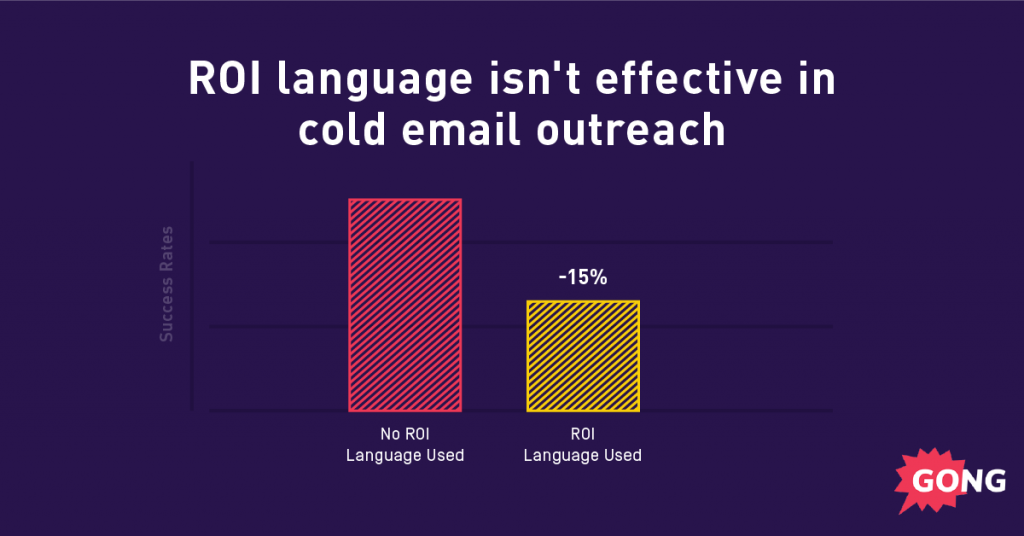
*Sales success = meeting booked in the next 10 days
And even if buyers “buy into” your numbers, it’s too early!
Instead, describe the actual problem your service solves. Provide context.
Then back those claims with strong ROI.
Sales Stat #2: DON’T ask for time when booking meetings with cold emails
We’ve all shared a link to our calendar in a cold email.
Or asked “What does your calendar look like next week?”
Or “How is Tuesday, 9 AM?”
Confession: Guilty as charged.
STOP. STOP. STOP.
We crunched the stats, and it turns out the “Interest CTA” is the highest performing call to action for cold emails:

The Interest CTA sells the conversation, not the meeting.
Time is finite. Most of us wish we had more of it. Your buyers certainly do.
So why would they give away some of their precious time to you (an unknown)?
Interest, however, is not finite. It’s not a resource. Salespeople tend to have more success when they can effectively pique curiosity through an Interest CTA.
Need one more data point? Steve, a CRO friend, did an A|B test and shared the results with me in this email:

Need more? Grab our 43 Highly Effective Email CTAs cheat sheet.
Sales Stat #3: DON’T ask “Did I catch you at a bad time?”
There are only 3 responses to “Did I catch you at a bad time?”
- Silence, followed by phone hanging up sound. Annoyed prospect.
- Yes, yes, you did. Annoyed prospect.
- Nope. Perfect timing! I was hoping you’d call!
It turns out #1 and #2 happen far more often than #3.
Opening a cold call with “Did I catch you at a bad time?” drops your chances of booking a meeting by 40%.
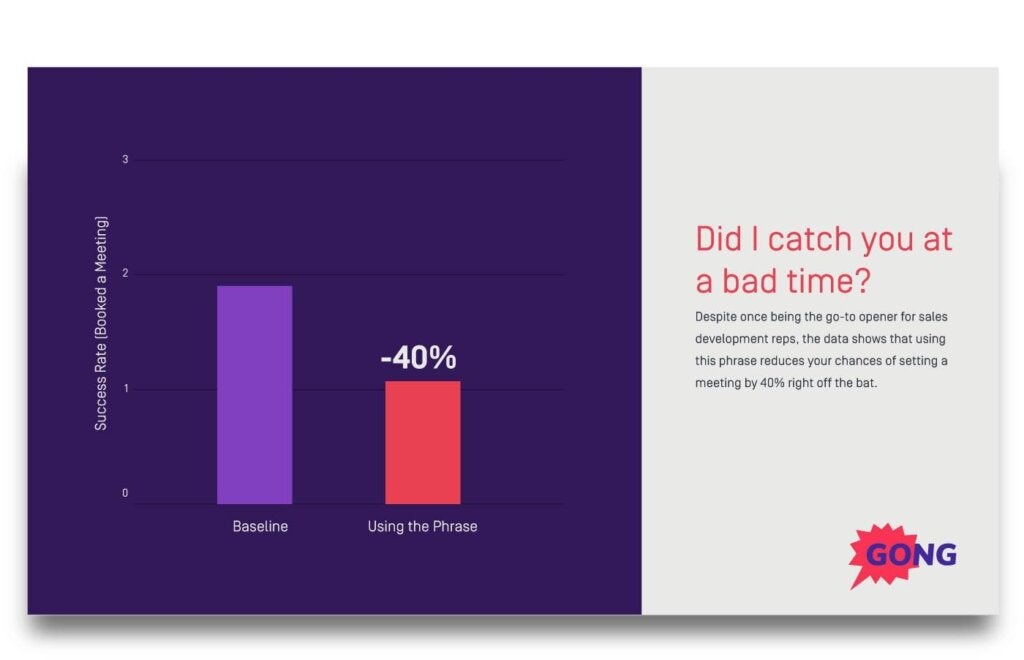
The success rate for cold calls that opened with this line? 0.9%. Yes, that was POINT NINE percent.
Instead, try this:
Sales Stat #4: DO ask “How’ve you been?”
Open up your next cold call with the following question:
“How have you been?”
Using the “How have you been?” line resulted in a 6.6x higher success rate than the baseline.
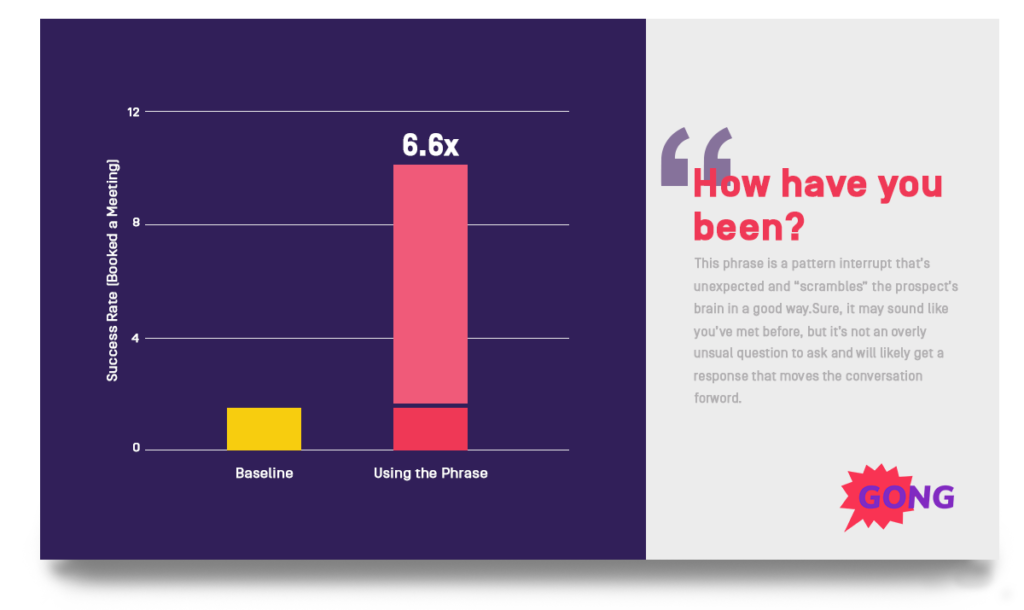
Cold calls that led with this question resulted in a greater than 10% success rate.
Note: This is for the first (cold!) call. “How have you been?” implies a previous interaction. Nope.
This tactic works because it’s unexpected. It’s a “pattern interrupt,” meaning it scrambles the receiver’s brain. A good (for you) kind of scramble.
Try it on your next cold call. Report back.
Sales Stat #5: Open with the reason for your call
Humans want crave reasons.
Give the people what they want!
The data prove it works: Stating the reason for (cold) call increases your success rate by 2.1x:
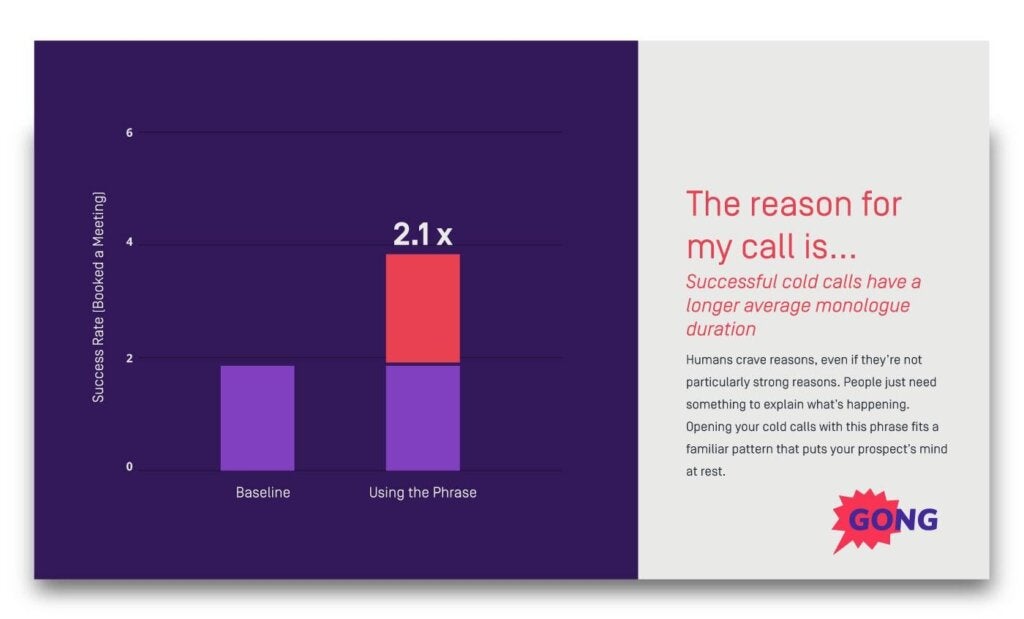
Put the buyer’s mind at ease by sharing the reason you are calling. Tell it early in the call, and don’t be afraid to repeat it later on in the conversation.
Reminder: Stats #4 and #5 (this one) are not one-offs. Instead, combine them with an opening to create a script like this:
Hi Kate, this is Jonathan Costet calling from Gong (state your full name and company name)
How’ve you been?
The reason for my call is…
Sales Stat #6: Avoid discovery
Your job in a cold call is not to listen. It’s to talk.
That’s counter to the advice we normally give sales reps. But remember, this is a cold call — your goal is to lock in a meeting… NOT learn more about the buyer’s needs (aka, discovery).
“Listen twice as much as you talk” doesn’t apply here.
In fact, the talk-to-listen ratio for successful cold calls is HIGHER than unsuccessful ones (55% talk vs. 45% listen):
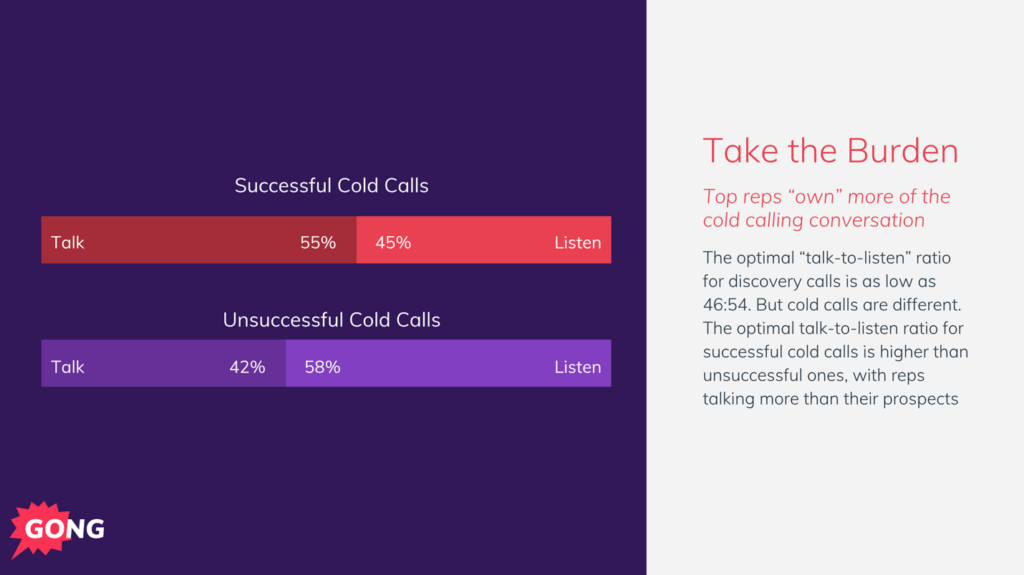
Don’t want to land that meeting? Talk 42% of the time and listen 58%.
Save the discovery-type questions (“What are your top strategic priorities” for post-meeting booked.
Spend the time talking, trying to sell that first meeting, NOT asking probing questions and listening. There will be a time and place for that only if you schedule a meeting.
Sales Stats For Sales Calls
Sales Stat #7: Turn on your webcam!
2020 was the year of the video call (and a few “other” things).
Outside sales reps went from in-person meetings to calls over video. Inside sales reps jumped on the bandwagon and moved from phone-only to video chats.
But a video conversation without your camera turned on is just a phone call.
Turn on our webcam!
The data prove it will be worth that extra click: Deals are 127% more likely to close when the video is used during any point in the sales process:
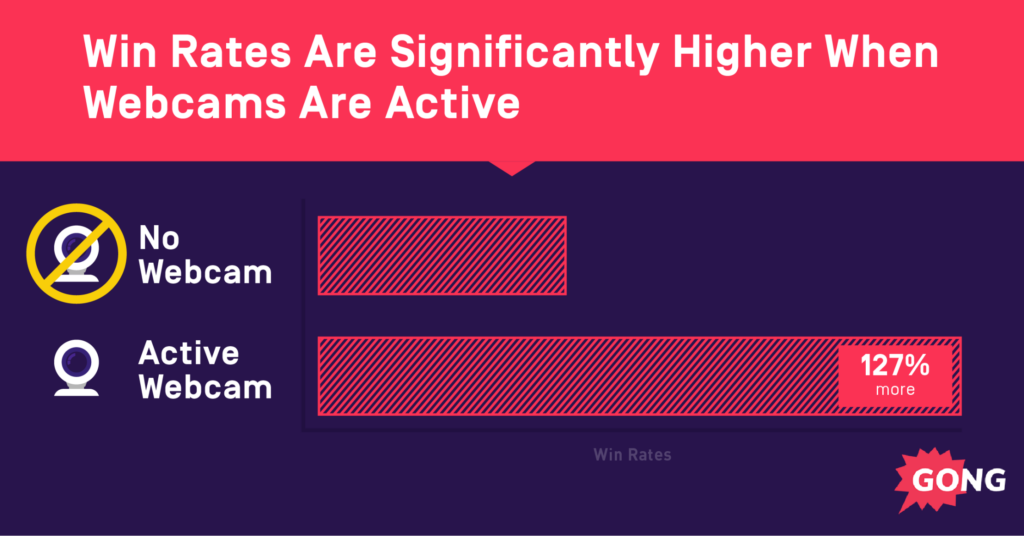
127% higher? Yes, please.
As a seller, you should always (yes, ALWAYS) have your video turned out. Again, the data prove it out: Win rates are 94% higher for deals where sales pros sell with video on (the stats aren’t even close):
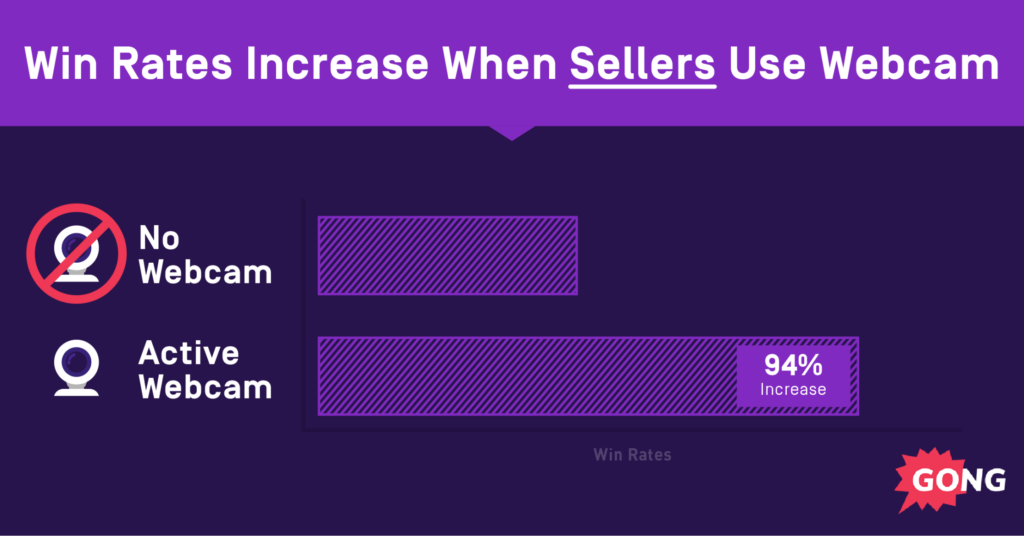
And if you can get your buyer to turn their video on, that’s just gravy.
In 2020, Gong data said when a buyer’s webcam is turned on, win rates increase by 96%:
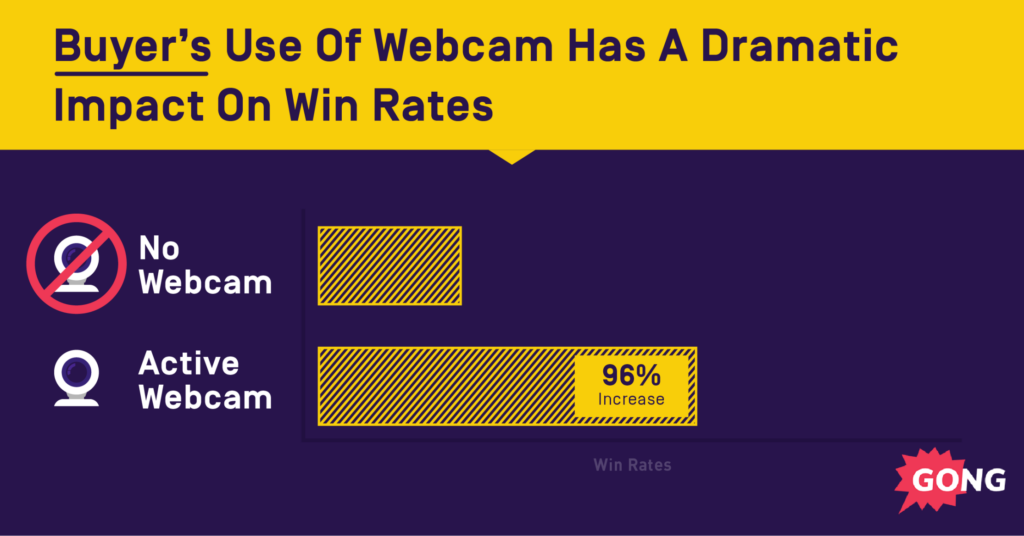
Here’s are 3 scripts to use to get buyers to turn on their video too:
- Will you be using video for our call today?
- Are you comfortable turning on your video?
- Are you in a place where you can turn on your video?
Before you start your next video call, check out these 10 tips for deal-making video calls.
Sales Stat #8: It’s OK to curse
No f–ing way.
Yes way!
But wait.
Before you drop an F-bomb on your next sales call, let’s add one crucial caveat: Wait for the prospect to swear first:

A sales rep is 4x more likely to swear on a sales call if the buyer curses first.
When a buyer is the first to curse, they are signaling something: they’re putting their professional guard down. It’s now okay to drop formality and social expectations. They are showing their “true” selves and beginning to build rapport.
And here is the good news about swearing on a sales call: If you can pull it off without offending your buyer, you are winning — literally.
Gong Labs data show there is an 8% increase in close rates when the salesperson and the buyer curse on the call, compared to nobody cursing at all:
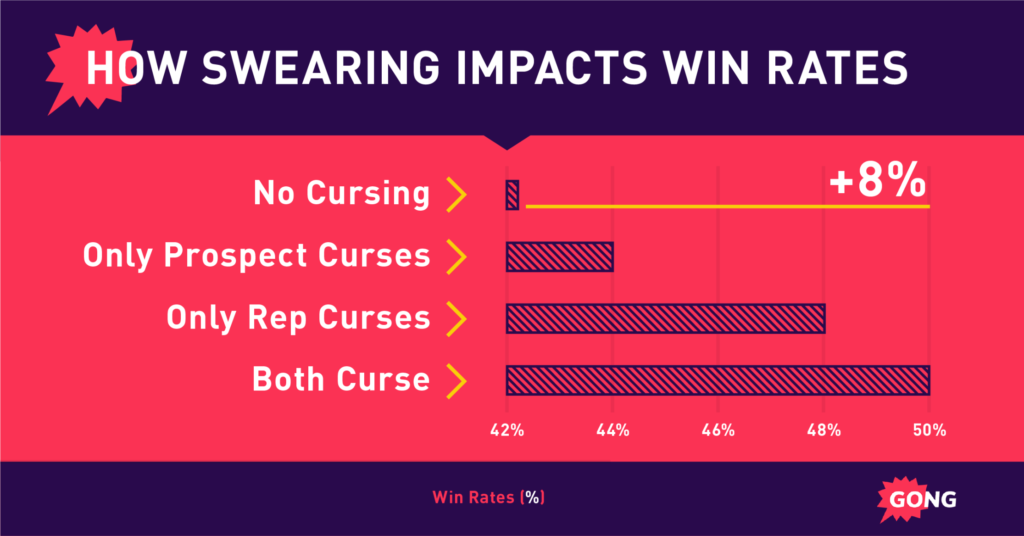
8% can be the difference between just missing your goal and exceeding it. Cursing during a sales call can supercharge close rates.
H$%L YEAH!
Sales Stat #9: Listen first, talk later
The stats are in:
Top sales reps listen more compared to average salespeople.
The best sellers have a “talk to listen” ratio of ~46%. Average salespeople are in the high 60s:

Sales Stat #10: Finish with next steps
Do you want to close deals quickly?
That was a rhetorical question. Of COURSE, you do!
Good news: Securing “next steps” has a considerable impact on shortening the sales cycle.
In the fastest deals, the seller spent 53% more time discussing “next steps” during the first meeting in the sales process compared to the average deals:

Sales instincts, validated.
Sales Stat #11: Use these words that sell
Top sellers use the best* words.
*Best = words that increase the chances of a deal moving forward in the sales cycle and eventually closing.
These “best” words subconsciously cause buyers to stand up at attention metaphorically.
These “best” words get dropped in everyday conversation, effortlessly, by the top sales reps.
For example:
You. Your. Your team.
The most important person in the world is always the person you’re speaking to (your buyers).
These words that sell put buyers in charge, helping them imagine what it’s genuinely like to use your product or service.
Get the complete list of words that sell.
Sales Stats for Discovery
Sales Stat #12: Using slides on discovery calls decreases success rates
Let’s just jump right into this one.
Our data found a strong negative correlation between the use of slides in discovery meetings and the likelihood of earning a follow-up call.
Here are the stats:

Discovery calls that used slides were 17% less likely to book a follow-up meeting than those that went slide-free.
It’s important to caveat this stat with the following: The slide/no slide decision only affects the first (discovery) call.
Success rates increase when sellers present slides in mid and late-stage meetings. One could interpret this as slides in and of themselves aren’t necessarily a turn-off to buyers. It’s just that slides are a no-no on discovery calls.
Slides are less about conversation, more about presentation. And discovery calls should feel like an in-depth conversation.
Sales Stat #13: Talk price early in the cycle
Fine. We’ll say it. Discuss pricing on the first call.
What? That’s crazy.
I know. It does sound counterintuitive, but hear me out (and trust the data):
Win rates are highest when sellers discuss pricing on the first call — 10% higher.
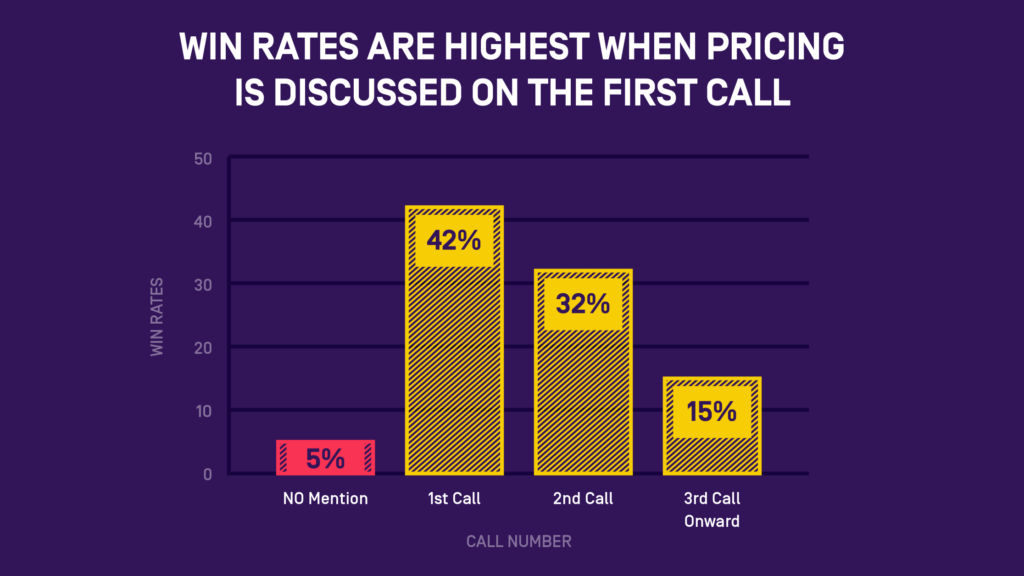
As the chart shows, the longer a salesperson waits to discuss pricing, the less chance of closing the deal.
Pricing sometimes feels taboo to discuss – especially so early in the sales relationship.
BUT introducing pricing early helps to identify intent.
Window shoppers will dodge the conversation, while buyers looking to buy now will welcome it.
However…
Sales Stat #14: But save price for last
Gong data also show while you definitely should discuss pricing on the discovery call, it’s best not to start the conversation with money.
The best-of-the-best sale reps bring up price in the 38-46 minute window:
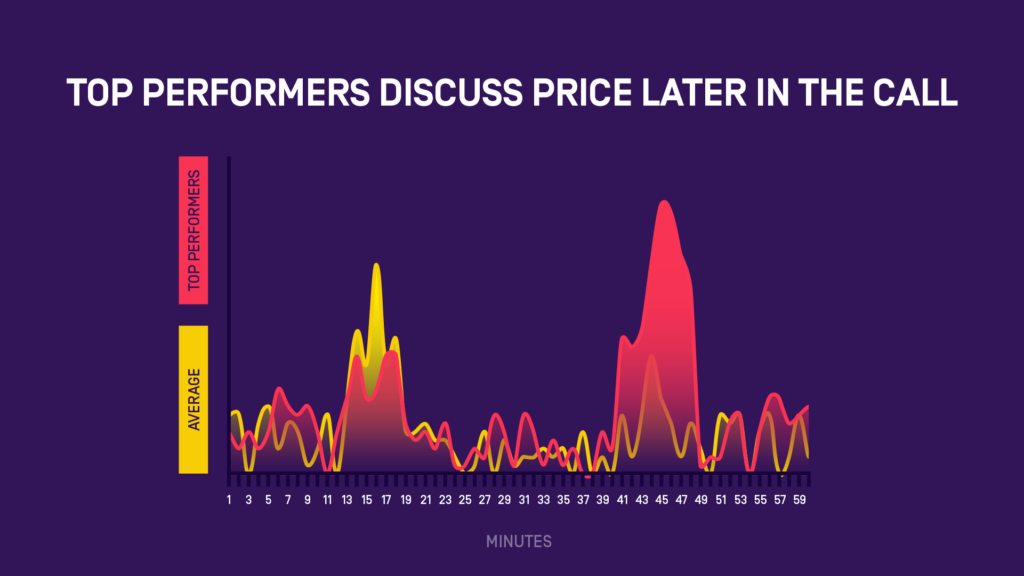
That still leaves plenty of time to build your value prop.
Then start talking about pricing.
Sales Stat #15: Avoid one-size-fits-all social proof
Social proof — using endorsements, logos, reviews to build credibility with potential buyers — can be the icing on the cake to help close a deal.
It can also backfire.
Sellers who use social proof techniques in their sales calls have a 22% lower close rate (in general):
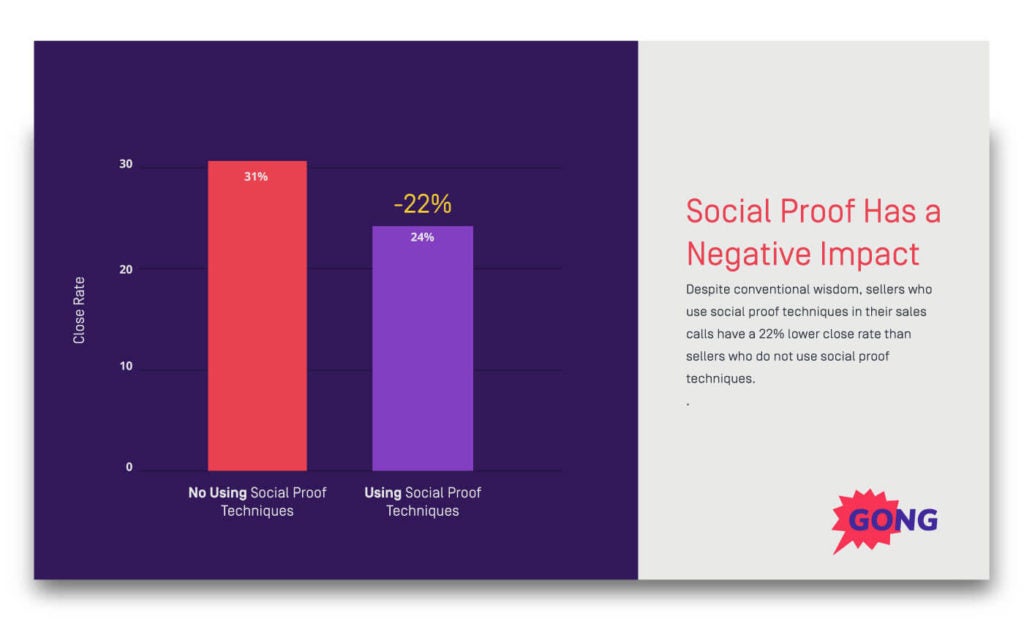
Whomp.
And it gets worse…
Leveraging social proof techniques during early-stage calls decreases close rates by 47%:
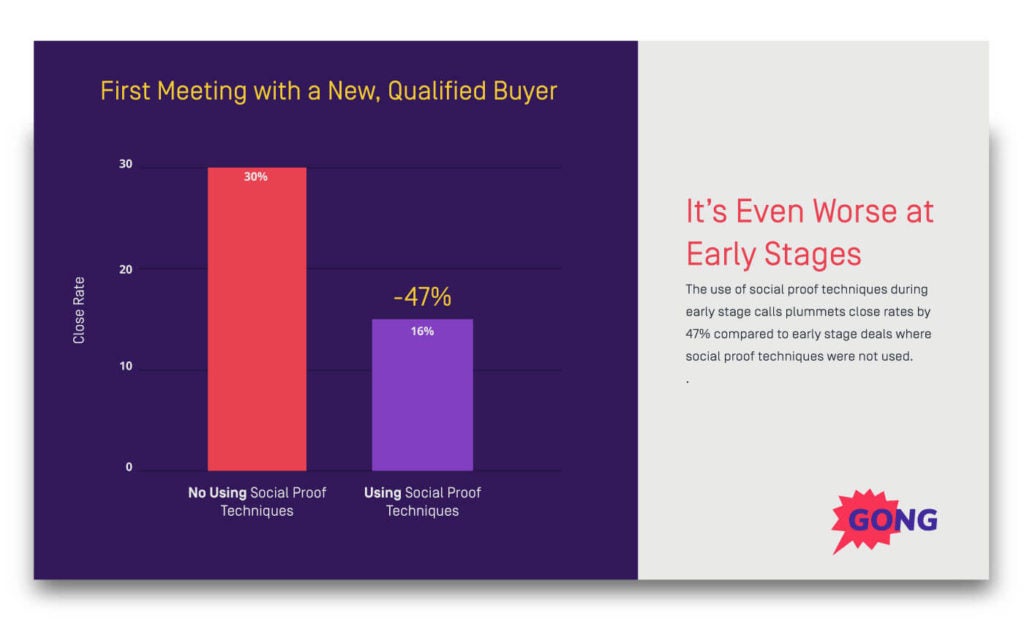
The cold hard truth: Social proof is most often misapplied in sales.
Want to see how to use social proof to your advantage? Read Chris Orlob’s full blog post here.
Sales Stat #16: Phrase questions to get long answers
Yes. No. Not sure.
When buyers answer your (amazingly incredible, superbly well-crafted) questions with a short yes/no/not sure, it’s… frustrating.
It also turns out that short answers means your deal is less likely to close.
That’s right: When buyers give you more information, you’re not shooting in the dark. You’re at the sitting on the same side of the table. And that’s when deals really start moving fast.
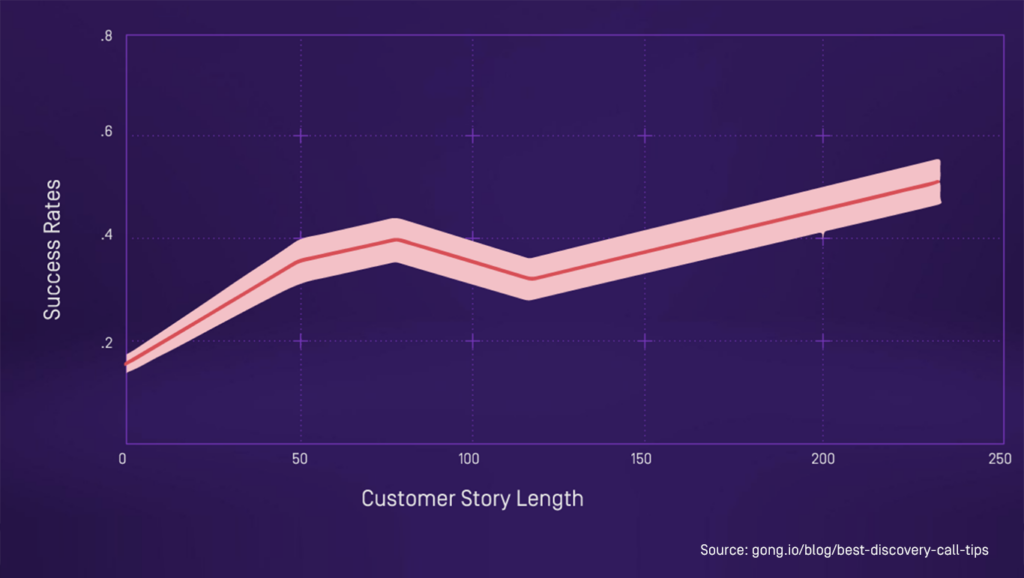
You can get a longer reply by signaling you want a… longer reply. Do that by phrasing your questions as follows:
- Can you help me understand…
- Can you walk me through…
- Can you tell me about…
- Talk to me about…
For example, instead of asking: “What’s your biggest challenge?”
Ask: “Can you help me understand your biggest challenge?”
This approach will turn into longer, richer, more insightful/valuable answers (and more closed-won deals).
Sales Stat #17: Shoot for 11-14 targeted questions
Q: What’s the ideal number of questions to ask on a discovery call?
A: Between 11 and 14
Ask less and you aren’t getting enough information.
Ask more and buyers tune out.
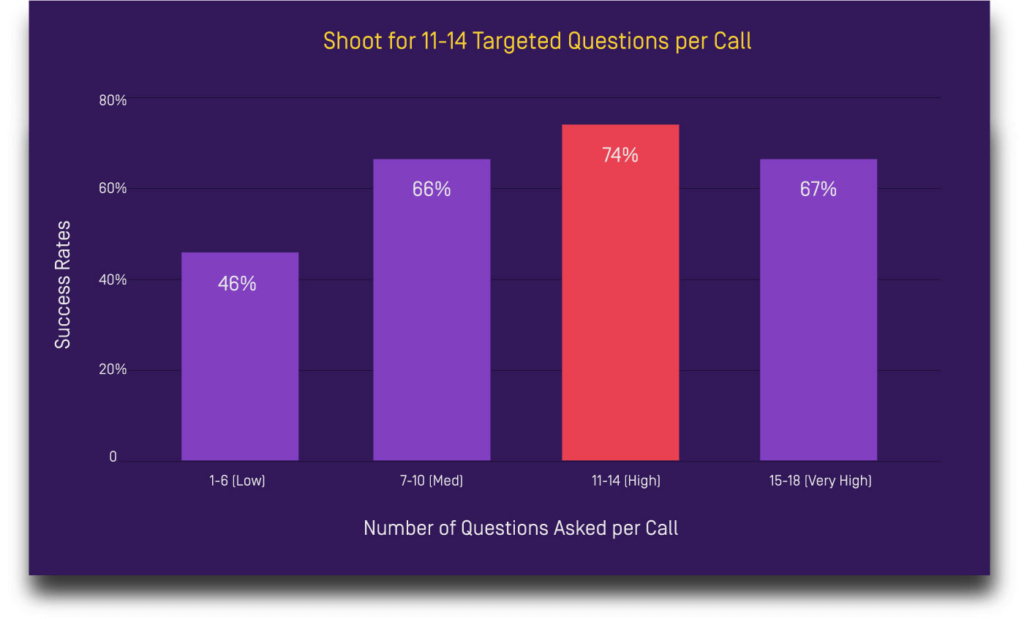
HOWEVER
Quantity does not mean quality.
Ask questions that make you sound like a subject-matter expert (i.e. questions your buyers would ask a peer).
Check out this post for inspiration.
Sales Stats For Pitching
Sales Stat #18: Don’t sell on ROI
Want to know one of the worst ways to build your sales business case?
Pitch ROI.
Presenting ROI at any point in your sales process correlates with a 27% drop in close rates.
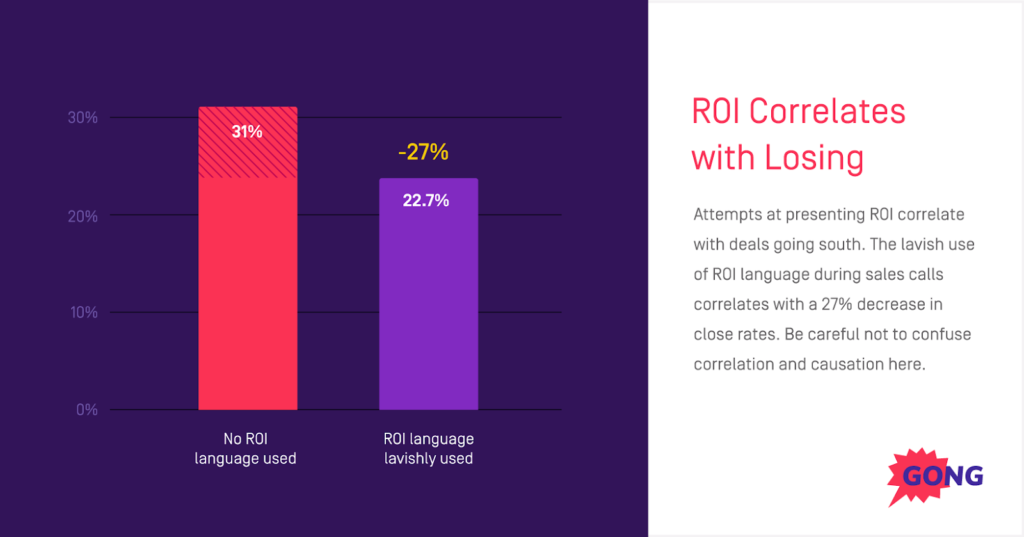
To be fair, we are talking correlation, not causation. So a conversation around ROI may work. However, any of the following may be true:
- Presenting ROI doesn’t work.
- Presenting ROI does work, but can end up sounding “too good to be true” and backfiring.
- Presenting ROI turns into a last-minute (desperate) attempt to save a dying deal.
But guess what? It doesn’t matter if it’s 1, 2, or 3.
Over-indexing on ROI to seal the deal is still a risk.
Not a silver bullet.
If you’re ready to say bye to ROI, here’s what to do instead.
Sales Stat #19: Don’t feature dump
Here’s an (underrated) key to super-effective sales demos:
Exactness.
Your demo should EXACTLY solve your customer’s business problem.
No less.
But, also, no more.
Almost everyone shows MORE than what will EXACTLY solve the problem.
Solve exactly.
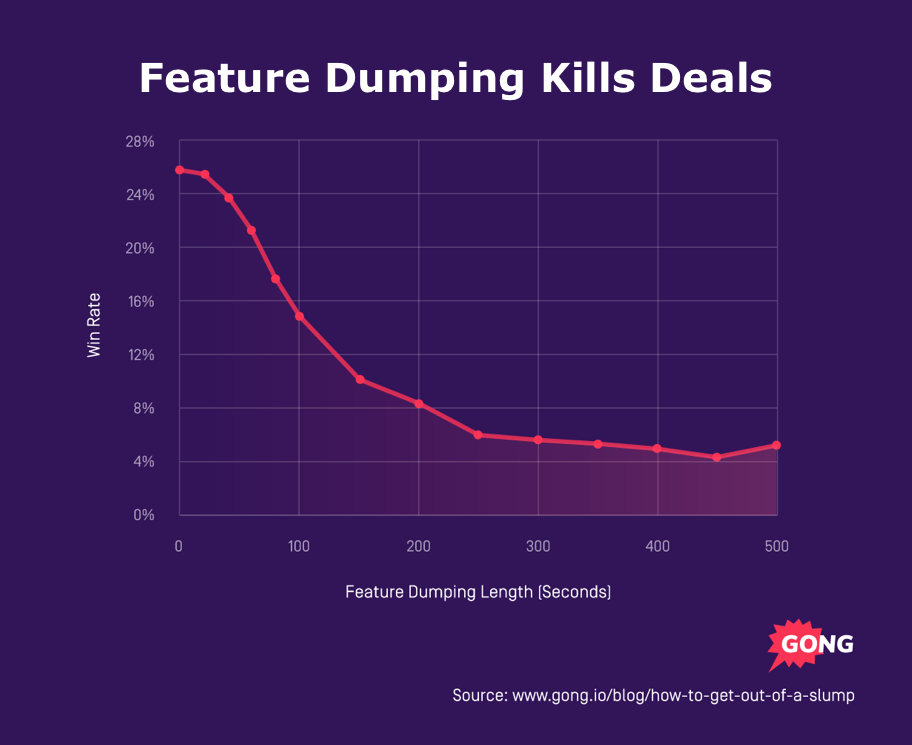
Sales Stats #20: Stick to 9 minutes
The Gong platform recorded the audio and video of 121,828 web-based sales meetings and analyzed them with AI to uncover this gem. We were specifically looking for the content sales reps shared over video (slide decks, product demos, web conferencing, and so on).
The data were pretty compelling:
Intro meetings that ultimately led to a closed-won deal spent — on average — 9.1 minutes sharing sales deck presentations. Compare that to 11.4 minutes for losing deals.
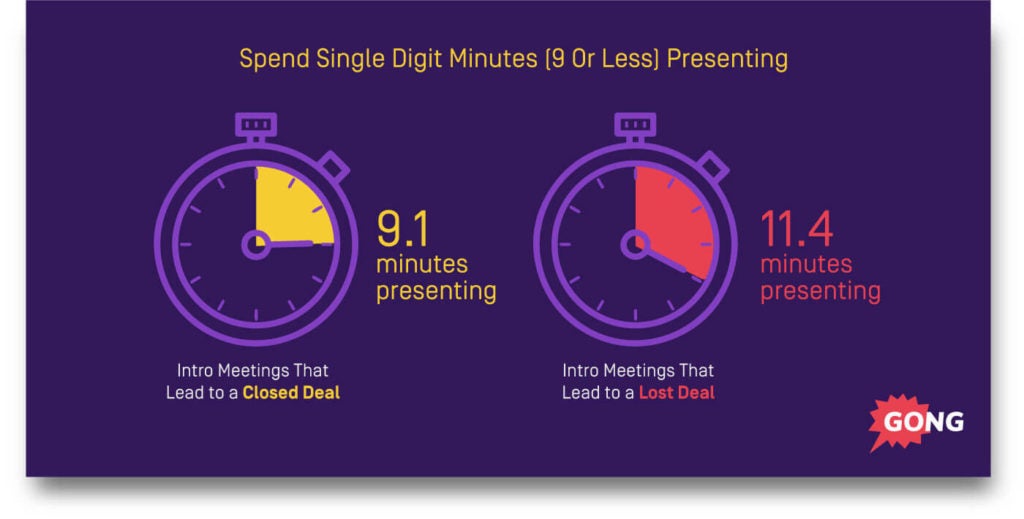
Human brains get bored fast.
Neuroscientists have proven that our brains have a built-in stopwatch that stops around 9-10 minutes (Coincidence? I think not). To command the person’s attention on the other end, you need a brain-perking” event: a new speaker, a video or demo, a dramatic story, etc.
Steve Jobs was known for being a pro at this 9-10 minute mark change.
Break your sales presentation into 9-minute chapters, including transitions with other speakers, opening the conversation, or sharing a different medium at those key moments when attention starts to dip.
Sales Stats For Objection Handling
Sales Stat #21: Hit pause
Successful reps pause…
after objections.
The best-of-the-best salespeople pause 5 TIMES longer than the average rep after objections compared to the “normal” parts of a sales conversation:
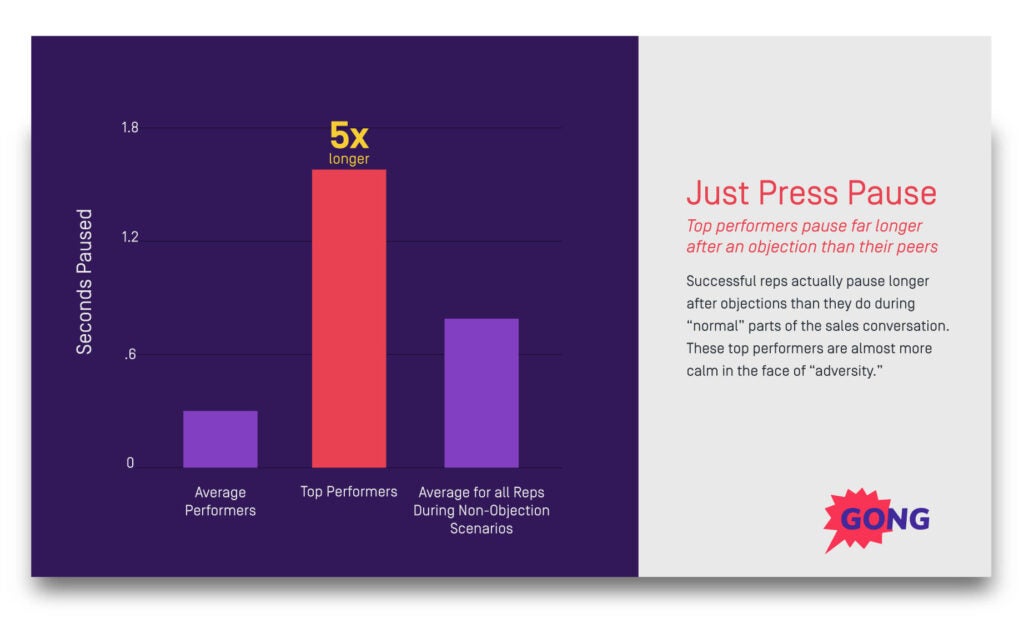
Top sales reps all do this.
When they get hit with a flurry of objections.
They slow down (matrix style) and pick them apart one by one.
Sales Stat #22: Slow it down
Speaking of slowing down… it turns out there is no prize for speakingreallyreallyreallyfast.
Just the opposite is true for successful sales reps after hearing an objection.
Top producers take their time (176 words per minute) when responding to objections. They maintain the average talking pace of 173 words per minute.
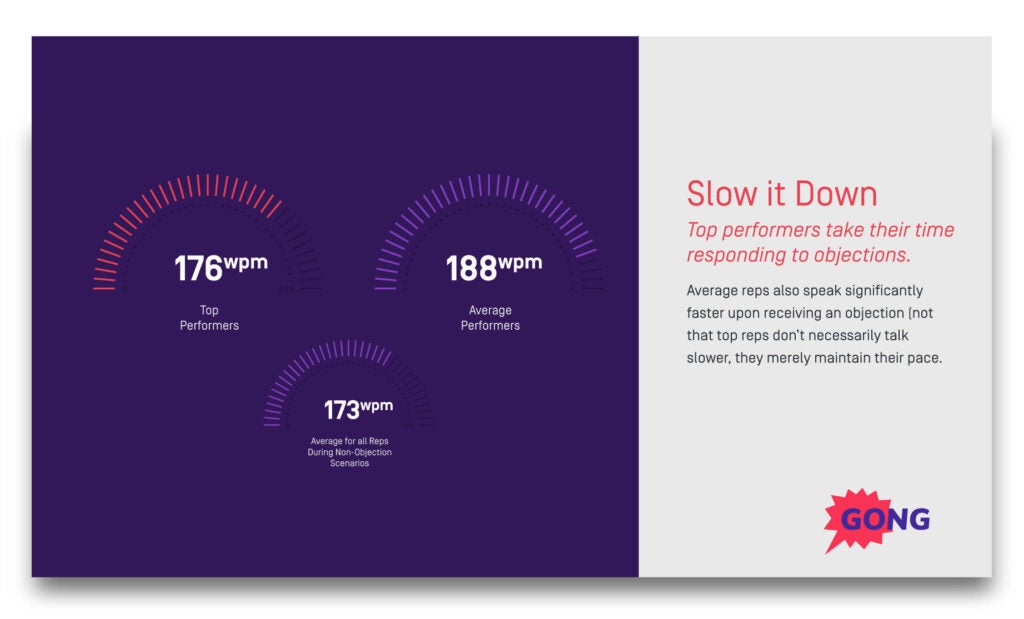
Compare this speaking rate to the average performer: When flustered by an objection, the middle-of-the-road sales rep will speed up to 188 words per minute.
If you maintain a calm demeanor amid a flurry of objections, you’ll project rock-solid confidence with the information presented.
Sales Stat #23: Respond to objections with questions
Objections are seen as a threat for the average seller.
But to the top sales reps, objections are opportunities.
The best salespeople do not get flustered when a buyer’s objections to (price, timing, features, etc.). They don’t get thrown off their game. They don’t panic over the “unexpected conversational redirect.”
The top reps respond to objections by asking questions — at a rate of 54.3% of the time compared to 31% for average sales reps.
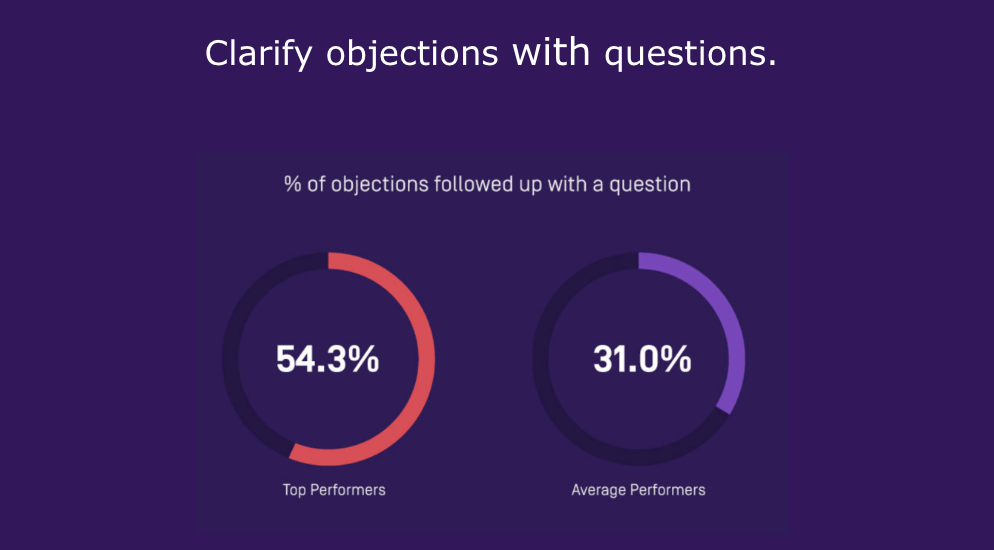
Asking these clarifying questions accomplishes two critical things:
- It makes buyers feel heard
- It gives you more ammo to clear the objection
Stay in control of the conversation without dominating = WINNING.
Sales Stats For Closing
Sales Stat #24: DON’T use the word “list price”
Wobbly. Movable.
That’s what your pricing looks like when you, the sales pro, utters the phrase “list price.”
When you say “list price,” you are inviting your buyer to start negotiating on price. Not good.
List price OR typical price OR standard price: Using any of those phrases at any point in a deal means the sales cycle will take 19% longer than average.
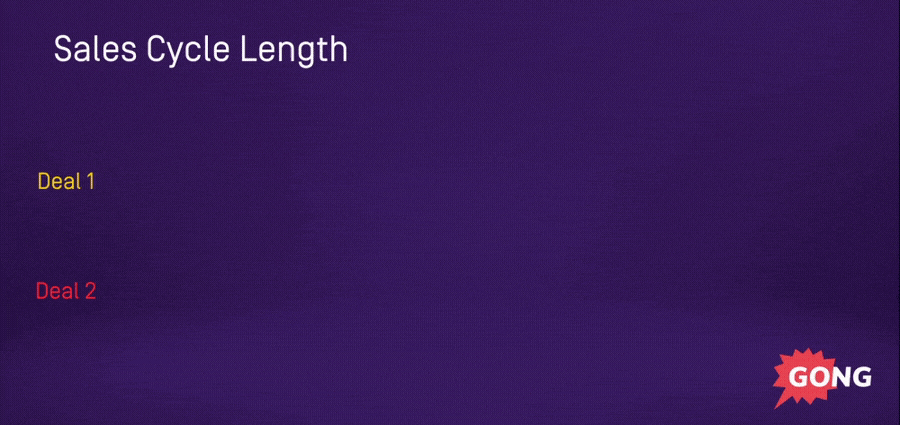
That extra 19% could be the difference between a deal closing this month/quarter/year and getting pushed to the next cycle.
Sales Stat #25: Negotiate over phone AND email
Good news: it’s safe to share price via email.
Discussing price over email has a significant, positive impact on win rates:

BUT once you introduce pricing — and once your buyer asks for anything related to pricing — a negotiation has begun.
AND when the negotiation begins, it’s time to get proactive STAT.
HOWEVER, negotiating price over email is not good form:
- Meaning is over lost over email: 50% of written communication is misunderstood by the recipient (Nick Morgan, Can you Hear Me?).
- It gives buyers the upper hand of TIME: your buyer can take as long as they want to think it over (more on that next), bring your offer to a competitor, and eventually counter.
INSTEAD, handle price via phone AND email: Win rates are significantly higher when pricing is covered over both channels instead of only one:

Use this script to kick negotiations out of your inbox and onto the phone (where you want them):
Hi [PROSPECTNAME],
Totally get where you’re coming from. Let’s hop on a quick call to align pricing with your budget plus answer any questions. I’m sure we can knock this out in 7-9 minutes tops. Does tomorrow at 4PM work?
[EMAILSIGNATURE]
Sales Stat #26: Don’t get spooked when your buyer tells you they “need to think about it.”
“I need to think about it” is not what you want to hear during the sales cycle.
It feels like the deal is dead in the water, but as Lee Corso is famous for saying, NOT SO FAST. Let’s turn to the stats.
When buyers tell you they “need to think about it,” it does NOT negatively impact win rates.
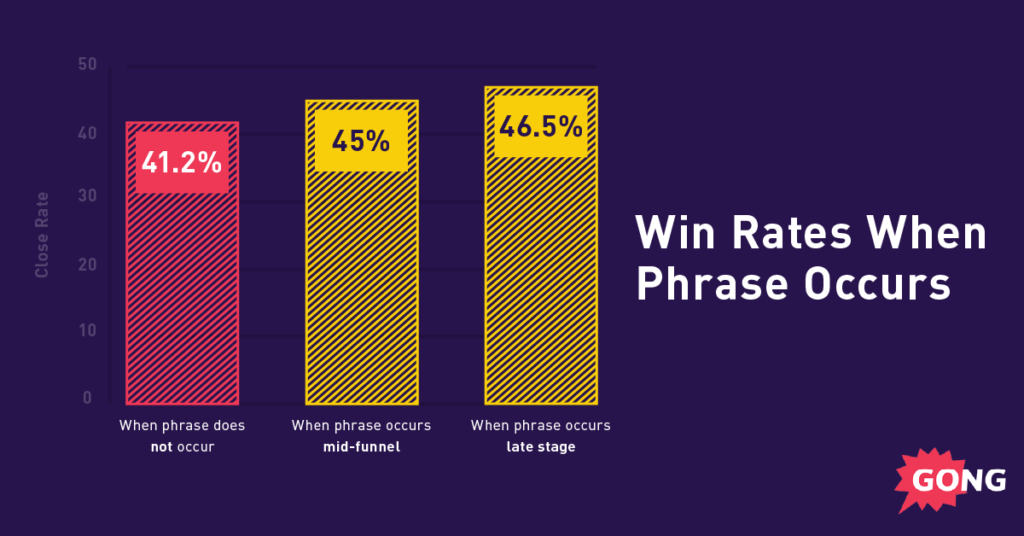
Wait. What?
Isn’t “I need to think about it” just friendly-speak for “Yeah, no. Not interested.”??
Nope. As the data shows, deals that include that phrase show a slight uptick in win rates. Nice! However, it does mean the sales cycle will extend by an average of 173%:
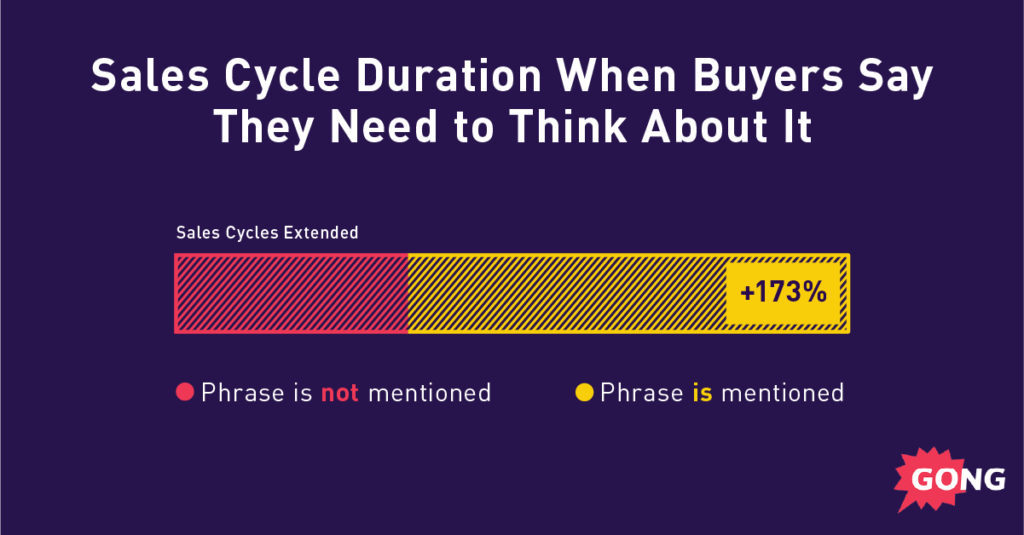
It isn’t “game over.” But it is going to take more work.
Sales Stats For Pipeline Management
Sales Stat #27: Use the specific CTA to move deals forward
Remember Stat #2 where we recommended using the interest CTA to get attention in a cold email?
We still stand by that.
HOWEVER, there is a catch. As soon as you enter the sales cycle, it’s time to transition to the “specific CTA” — ask for a meeting on a specific day and time:

Why? You know they are interested, so you need a direct, to-the-point approach. Confirm a time and send that calendar invite ASAP.
The goal: have that “invite accepted” pop up in your inbox ASAP.
Sales Stat #28: Use email velocity to forecast deals
This is one of my favorite sales stats:
The #1 signal that your deal is going to close is… high email velocity, the number of emails exchanged between buyers and sellers.
In essence, it’s measuring to what degree your conversations are two-way (vs. you, the seller, just blasting messages into the ether).

REMINDER: Email velocity is NOT how many sales emails you send prospects.
And, this is a correlation metric, not a causation one.
But one thing is for sure: Closed-won deals exchange more emails per week compared to Closed-lost ones. Pipeline management software can flag when it happens (and when it doesn’t) so you know what deals are closing this quarter.
Sales Stats #29: You NEED to get to the decision-maker
Intuitively, we all know that getting a decision-maker (DM) into a sales conversation should help the deal cross the finish line.
And the data proves it.
SMB deals that don’t involve DMs are 80% less likely to close:

Getting the DM involved in the sales cycle has even more impact on those 6-figure+ enterprise deals.
Enterprise deals are 233% less likely to close if the DM isn’t involved:
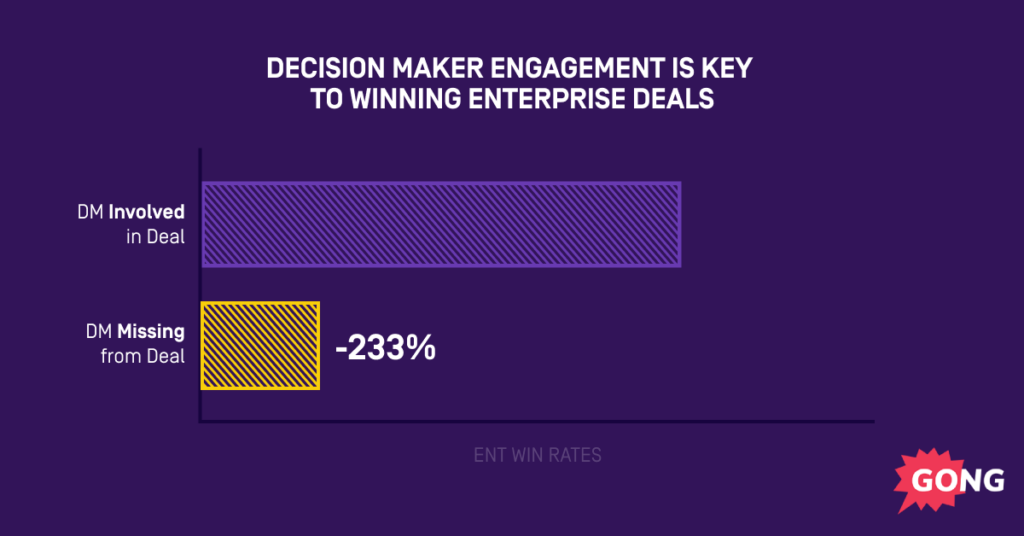
Said another way, it’s virtually impossible to close enterprise deals without a DM directly involved.
Sales Stat #30: Sell as a team
If I told you you could do THIS to lock in a 258% higher likelihood your deals will close, you’d do it, right?
The chance of closing a deal on calls with multiple participants from the seller’s organization is 258% higher than if you try to roll solo.
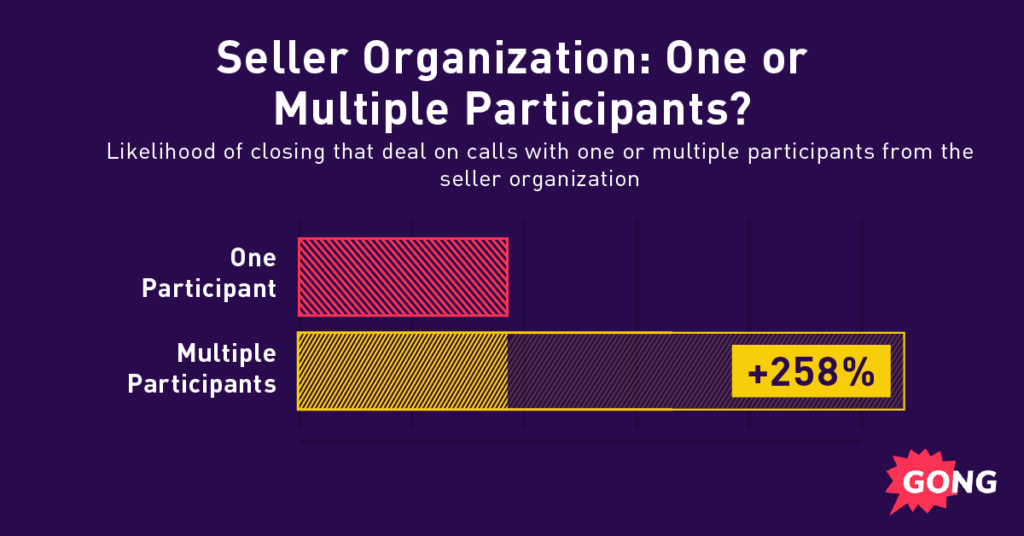
Whoa. That’s compelling.
Gone are the days of lone wolf sales pros.
Successful teams rally on deals.
Goodbye, Opinions. Hello Reality.
In a battle between opinions and reality, in Gong’s world REALITY crushes opinions.
Revenue Intelligence doesn’t rely on a human being to determine what’s important. It simply captures everything—even those tiny details that might make all the difference in a sale.
And Revenue Intelligence and reality is what we are all about here at Gong. We provide your organization data and insights on your team, your deals, and your market so you can win more and win more often.
Check out Gong for yourself. Chat with one of our sales pros today to learn how you can move away from opinions and into a world of reality.


